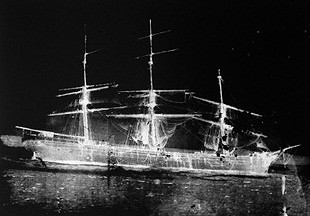THE ART OF THE SHIPPE SWALLOWER
A new exhibition celebrates the dangerous Goodwin Sands and their delicate ecological balance
Just four miles off the coast of Deal lies a place of treachery – amythical place with a dark and stormy history that has claimed countless lives and inspired myriad stories. This place, the Goodwin Sands, is a huge, ever-shifting sandbank hidden just below breaking waves at high tide. It has become, over the centuries, the final watery resting place of some 2,000 ships and 50,000 unfortunate souls.
This autumn, Taylor-Jones & Son has teamed up with the Goodwin Sands Conservation Trust to launch an exhibition, Dark and Stormy, dedicated to these infamous sands, their wrecks, wildlife and heritage. Launching on Saturday 22 October, the exhibition explores the reality of the Sands, named after Godwin, 11thcentury Earl of Wessex, and also takes a brand new look at them through the eyes of the gallery artists.
In the gallery’s Georgian wine vaults beneath the high street, visitors can take a trip back in time. With a Tudor iron swivel gun eroded by sand and sea, cannon balls and East India Company tokens and so much more, the exhibition will reveal a wealth of artefacts hidden beneath the sea for centuries.
The Goodwin Sands Conservation Trust was created in 2018 to “conserve and protect the natural and historical environment of the Goodwin Sands”. The charity works tirelessly to raise public awareness of the importance of the Sands, not only as part of our national maritime heritage and marine environment but also as a natural sea defence for this stretch of coast. They are also campaigning to introduce effective legislation that will protect this unique area, which is under threat from dredging and aggregate extraction.
Jo Thomson of the Goodwin Sands Conservation Trust says, “Teaming up with Taylor-Jones & Son is the perfect opportunity to show the town’s visitors and residents the wealth of history the Sands offer alongside their impact on the local environment and culture.”
Following in the tradition of the Goodwin Sands as a muse for artists, nine of the artists represented by the gallery have created work inspired by the Sands. The intrepid painters and photographers explored the Goodwins by helicopter and boat, soaking up their ambience both visually and atmospherically to make brand new pieces especially for the exhibition. For Richard Taylor-Jones, the helicopter trip over the Sands was a real adventure. With the doors open and wind buffeting him at 500 feet above ground, the shoot was exhilarating and ever so slightly nerve-wracking. “I’ve been fascinated by the Goodwin Sands for as long as I can remember,” he explains. “As a child I used to see the masts of wrecks as I played on the beach. I first visited them when I was making a BBC film about the seal colony on the Sands, but this time, getting to them by both helicopter and boat has given me the chance to look at them from an artistic, rather than an informative perspective.” Richard’s photography created for the exhibition is a mix of aerial shots taken on the helicopter expedition and something new and exciting he will unveil on the opening night.
Two other photographers, Rachael Talibart and Michele Turriani, have created work in their own inimitable style for the exhibition. Rachael, a world-renowned ocean photographer, has focused on the Sands themselves, while Michele has photographed his signature gloriously blowsy blooms arranged in a vessel rescued from the Goodwins.
Richard Whadcock, Christine Hodson and Richard Friend have painted their own interpretations of the Sands. Christine is known for her paintings of the white cliffs and Richard Friend for his forest and street scenes, so the Goodwins were a new departure for both of them. Richard Whadcock’s atmospheric landscape style lends itself perfectly to summing up the eerie reputation of the treacherous sandbank. His painting will let viewers interpret the content in their own way, picking out new details each time they look at the canvas.
Legend has it that the Lady Lovibond, a schooner wrecked in 1748, appears in chilling spectral form every fifty years. Loren Beven has created a screen print, complete with glow-inthe-dark rigging, of this apparition (see above), along with a series of imagined portraits of ship’s captains from the wrecks that now languish on the Sands. The undulating ripples in the sand fascinated David Hunt on his trip, this multidisciplinary artist has made an oak carving of these patterns alongside an oil seascape. The Goodwin Sands are also home to a thriving seal, colony and sculptor Adam Binder has cast a seal in bronze for the gallery in their honour. All these works will be on display for the very first time at the launch of the exhibition and a percentage of the proceeds of sales on the opening night will be donated to the Goodwin Sands Conservation Trust.

Images courtesy of
Taylor Jones & Son

Looking out to sea from Deal Beach, many will see white horses breaking over the Goodwin Sands but be unaware of what lies beneath the waves. Melding the history and present day life of the Goodwins with contemporary art to reveal its secrets makes for a fascinating exhibition for anyone with a passing interest in what the sea is hiding just off our coast.
Dark and Stormy 22 October to 19 November, Taylor-Jones & Son, is open from 10am to 5pm, Wednesday to Saturday. For more info visit the website taylorjonesandson.co.uk